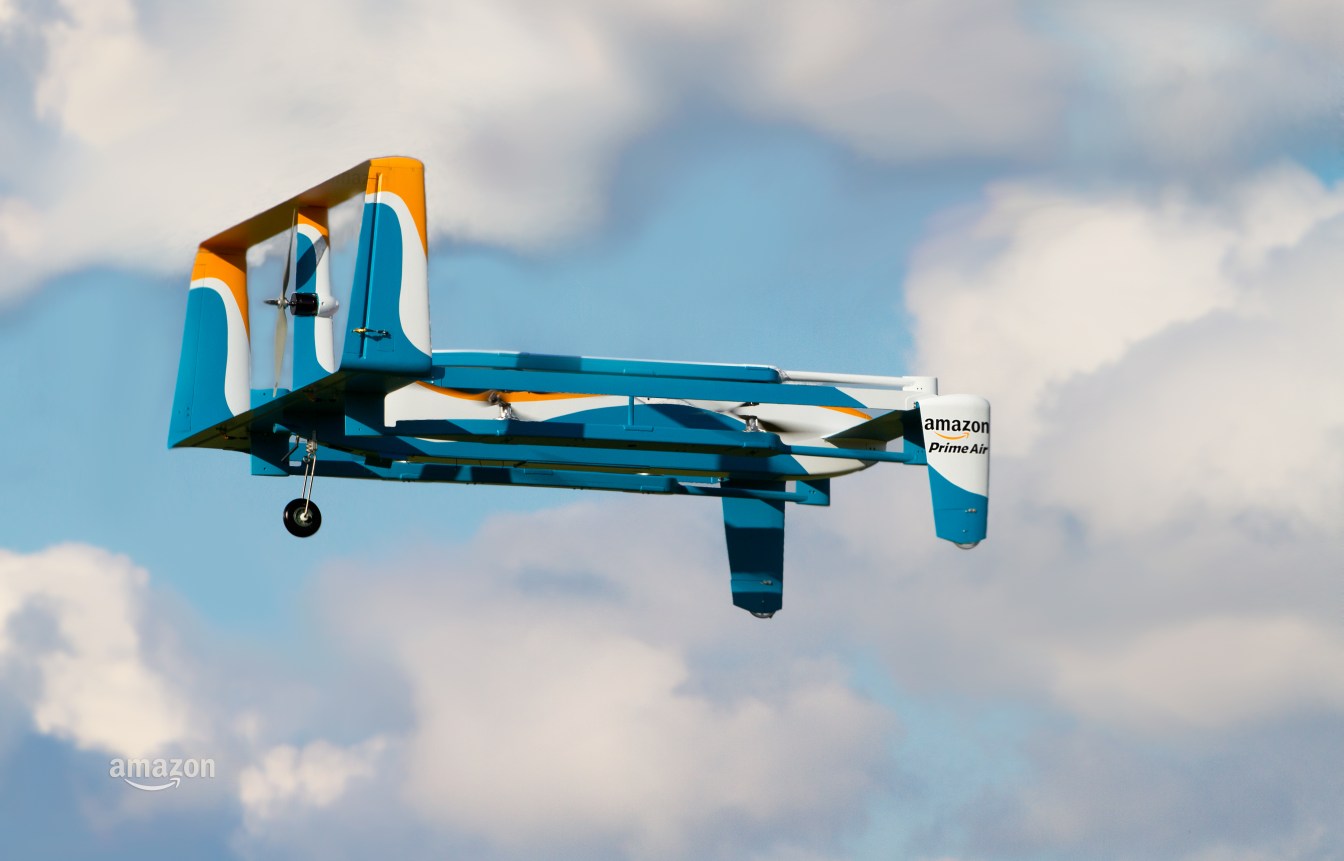Amazon delivered a lovely update on its ‘Prime Air’ project today — almost exactly two years after it showed the first iteration of its drone. You know, the flying delivery dronethat some thought was a massive joke meant for April 1st. Included are some high-res shots and two new videos.The video, moderated by ex-Top Gear host Jeremy Clarkson (who is now working on a new series for Amazon), talks about the design and your experience as a recipient:
As you can see, Amazon has now moved to a hybrid design. It looks much bigger than in previous renderings. Imagine that thing flying towards the neighbor’s house. Get ready for reports of aliens rising if this thing ever comes to fruition.
The new Prime Air drone isn’t just a quadcopter anymore. It still takes off and lands vertically, but then it switches to a regular horizontal flight mode, which is far more efficient. It’s basically part helicopter, part airplane. With this new design, the drone can cover over 15 miles and fly over 55 mph, Amazon says. In the video, Clarkson says Amazon is working on a family of drones for different environments and purposes.
The new drones feature at least some degree of sense-and-avoid technology and once it arrives at its intended location, it’ll scan the area and look for a landing spot. Right now, it looks like users will be able to mark this spot in their yard, for example, with an Amazon logo. The drone then lands, drops off the package and takes off again.
“This design enables it to fly long distances efficiently and go straight up and down in a safe, agile way. It is one of many prototype vehicles we have developed,” an Amazon spokesperson told us. “One day, seeing Prime Air vehicles will be as normal as seeing mail trucks on the road.”
Obviously, Amazon still has a few hurdles to climb, even with this new design. Chances are, we won’t see these new drones deliver packages in a city anytime soon. The new design, however, should work really well in a more rural and suburban area (and yes, feel free to leave us a comment about how you would shoot it down if it flew over your house).
If Amazon can solve some of the harder sense-and-avoid issues (like small power lines), then maybe Prime Air will take off sooner than many of use expected (assuming Amazon manages to work within the FAA’s upcoming regulations for commercial drones).
source & more: http://techcrunch.com/2015/11/29/amazon-shows-off-new-prime-air-drone-with-hybrid-design/?ncid=pushup

Comments
@Rob if it can "cover 15 miles", than it means to me it has to be able to fly 30 at least. Anyway it probably is a pr stunt as @Giovanni pointed, but it is a very positive pr for drone community :)
30 miles would be quite impressive ...
Hybrid ... Makes sense, get the best of both worlds.
Rob: 15 miles range for a VTOL with that size, some payload, and an industrial quality build is actually not bad at all. Sure much better can be achieved if pushing the performance envelope is the #1 goal, but is that really what they've been after? I'd think reliability, size and safety would be their first priorities.
Not very fast at all. however- im impressed at the cargo bay and the door system.
...and here we go again! Just before Christmas, exactly as 2 years ago, another pr stunts.
Intresting. There is not a lot of wing area on that thing. I wonder how efficient it is. Seems it would hardly have any lift at all from those wings without a large degree of AoA, which if they did that, would then have the lift thrust vector acting in opposition to the horizontal thruster? Seems like the wings are really more of just stabilizers than anything?
15 miles is not very far. Is that 15 miles each way, so 30 mile range? Or 15 miles total?
I'm not very impressed.
-
1
-
2
-
3
-
4
-
5
of 5 Next